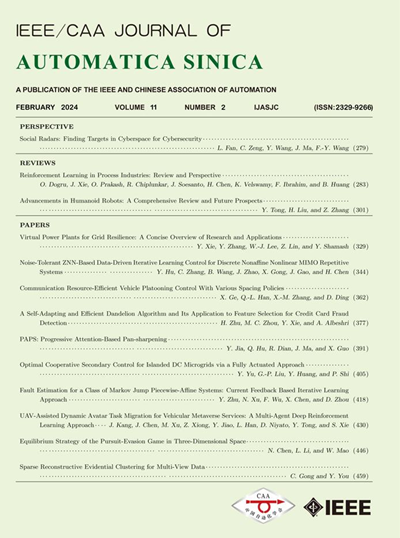滑模控制中的切换:一个时空视角
IF 19.2
1区 计算机科学
Q1 AUTOMATION & CONTROL SYSTEMS
引用次数: 0
摘要
滑模控制(SMC)以其鲁棒性和简单性被广泛采用。SMC的本质是使用不连续控制来驱动系统进入预定的运动,称为滑模,该运动被设计为具有理想的动力学特性。在滑模状态下,被控系统对匹配的不确定性和干扰不敏感。大多数SMC理论和方法都是基于连续时域的动态系统发展起来的,其中开关函数起着至关重要的作用。理想的开关应该是瞬时的,只要满足开关条件就会启动。然而,在实践中,开关机制受到诸如时间延迟、未建模动力学、缺陷、数字化效应和驱动限制等缺陷的影响,这些缺陷会降低SMC的显著性能。了解这些影响并制定缓解战略对工业应用至关重要。此外,网络控制环境的出现带来了新的挑战,如有限的通信带宽,延迟和网络攻击,最近出现了事件触发SMC。尽管取得了这些重大进展,但目前还缺乏全面的研究来研究在连续时间和离散时间领域以及其他领域中利用SMC开关的共性和区别。本文从时空角度,从状态-空间和时间两方面考察了开关在SMC中的作用。其目的是促进更好地理解其影响和不当行为,并释放其未来应用的全部潜力。分析了连续时间域和离散时间域SMC方法之间的相互作用,确定了它们的共同原理和各自面临的挑战。此外,还探讨了与跨这些时间域切换有关的重要技术问题,并描述了其理论和应用中的几个神话和陷阱。讨论了SMC与其他基于开关的控制系统的关系,如开关控制系统、模糊控制系统和事件触发控制系统。研究了网络控制环境对连续时间和离散时间域SMC的影响。最后,概述了SMC未来工作的主要挑战和机遇。本文章由计算机程序翻译,如有差异,请以英文原文为准。
Switching in Sliding Mode Control: A Spatio-Temporal Perspective
Sliding mode control (SMC) is a widely adopted control technology known for its robustness and simplicity. The essence of SMC is to use discontinuous control to drive a system into a pre-defined motion, called the sliding mode, which is designed with desirable dynamical properties. In the sliding mode, the controlled system is insensitive to the matched uncertainties and disturbances. Most SMC theory and methods have been developed based on the dynamical systems in the continuous-time domain, where switching functions play a critical role. Ideal switching is supposed to be instantaneous, activating as soon as the switching condition is met. However, in practice, switching mechanisms are affected by imperfections such as time delays, unmodeled dynamics, defects, digitization effects, and actuation limitations, which can degrade the salient properties of SMC. Understanding these effects and developing mitigation strategies are essential for industrial applications. Furthermore, the advent of networked control environments presents new challenges like limited communication bandwidth, latency and cyberattack, which have seen the emergence of the event-triggered SMC recently. Despite these significant advances, there is a lack of comprehensive studies which examine the commonalities and distinctions of utilizing switching in SMC across the continuous-time and discrete-time domains and beyond. This paper investigates the role of switching in SMC from a spatio-temporal perspective, considering both state-space and time aspects. The aim is to facilitate better understanding of its effects and misbehaviors, and to unlock its full potential for future applications. The interplay between SMC methods in the continuous-time and discrete-time domains is analyzed, and their shared principles and unique challenges are identified. Furthermore, important technical issues relating to switching across these time domains are explored, and several myths and pitfalls in their theory and applications are depicted. The relationships of SMC with other switching-based control systems such as switched control systems, fuzzy control systems, and event-triggered control systems are discussed. The impact of networked control environments on SMC in the continuous-time and discrete-time domains is also examined. Finally, key challenges and opportunities are outlined for future work in SMC and beyond.
求助全文
通过发布文献求助,成功后即可免费获取论文全文。
去求助
来源期刊

Ieee-Caa Journal of Automatica Sinica
Engineering-Control and Systems Engineering
CiteScore
23.50
自引率
11.00%
发文量
880
期刊介绍:
The IEEE/CAA Journal of Automatica Sinica is a reputable journal that publishes high-quality papers in English on original theoretical/experimental research and development in the field of automation. The journal covers a wide range of topics including automatic control, artificial intelligence and intelligent control, systems theory and engineering, pattern recognition and intelligent systems, automation engineering and applications, information processing and information systems, network-based automation, robotics, sensing and measurement, and navigation, guidance, and control.
Additionally, the journal is abstracted/indexed in several prominent databases including SCIE (Science Citation Index Expanded), EI (Engineering Index), Inspec, Scopus, SCImago, DBLP, CNKI (China National Knowledge Infrastructure), CSCD (Chinese Science Citation Database), and IEEE Xplore.
 求助内容:
求助内容: 应助结果提醒方式:
应助结果提醒方式:


